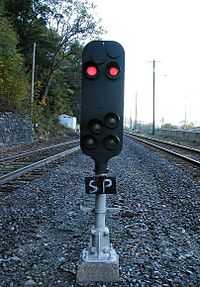Railway slide fence
Part of a railway signaling system, a slide fence is a fence whose purpose is to prevent trains from being derailed by rock slides in mountainous areas where rock slides may occur without warning. The fence is designed to be displaced by a rock slide, causing the signaling system to display a stop aspect on nearby signals.[1] As an alternative, a structural fence is designed to physically stop falling rocks from reaching the tracks.
Operation
Mechanical
The mechanical slide fence consists of a series of tensioned wires strung about 10 inches (25 cm) apart on poles. When a rock slide occurs, the rock breaks one or more of the wires. When a wire breaks, heavy weights attached to either end will fall. This mechanically triggers the protecting signals to the 'danger' position.
Electrical
There are two types of electrical slide fence in operation.[2]
One type of electrical slide fence consists of a series of parallel conductive wires strung about 8 inches (20 cm) apart on poles that create a fence parallel to the rails.
This creates an electrical circuit that is monitored by signaling equipment. In normal operation, the electric current in the fence wires causes a relay to energize, indicating that the fence is intact. When a rock slide occurs, the rock breaks one or more of the wires, interrupting the current. This causes the relay to become de-energized, indicating that a rock slide has occurred. A contact of the relay is typically used to prevent the approaching signal from displaying a proceed aspect if the fence has been broken.[3] Restoring normal operation requires splicing the broken fence wires back together.

Another type of slide fence is similar except that the wires do not have to break and is easier to maintain and reset. The slide fence consists of a series of fence sections, as shown in the SLIDE FENCE DETAIL drawing, which shows a typical installation. Each fence section is held in place by strong springs. At each end of a fence section is an electro-mechanical plug. The plugs maintain a complete electrical circuit that is monitored by signaling equipment. In normal operation, the current through the plugs causes a relay to energize, indicating that the fence is in place. When a rock slide occurs, the fence moves laterally, causing the plug to be removed, breaking the circuit. This causes the relay to become de-energized, indicating that a rock slide has occurred. A contact of the relay is typically used to prevent the approaching signal from displaying a proceed aspect if the fence has been broken.[3] Restoring normal operation requires re-inserting the plugs that were dislodged by the slide.
Structural fence
The structural fence is a physical barrier designed to stop falling rocks from reaching the tracks. Several construction methods are used, including: steel I-beams, wooden barriers, galvanized fencing, and netting directly against the rock.
Where used
A slide fence is typically found in mountainous areas in a rock cut area, where rocks may fall on the track and present a danger to passing trains. The length of the fence may range from 100 feet (30 meters) to several miles (kilometers), depending on the length of the rock cut and the area being protected. The slide fence is usually located on the uphill side of the track in the slide area.
Select examples of railroad slide fences:
- On the Union Pacific Railroad's Moffat Subdivision, trains pass through three major canyons - Byers Canyon, Gore Canyon, and Glenwood Canyon, all three of which feature rock fences.
- Stretches of the BNSF Railway's Hi-Line, such as on the western approach to Marias Pass, and a small canyon called Bad Rock Canyon east of Columbia Falls, Montana, are equipped with rock fences.
Consequences of slide fence activation

In North America slide fences are typically connected in such a way as to shunt the track circuit when activated. This causes signals on either side of the slide fence to display a restricting indication, requiring trains to travel at a speed enabling them to stop within one half the range of vision. On lines formerly operated by the Pennsylvania Railroad signals connected to a slide detector have an 'SP' placard, reminding engineers to watch for slides when governed by a restrictive speed signal.
Once the slide fence has been activated (even if in error), all trains are affected until the slide fence is repaired by maintenance personnel. This may result in several hours of delay in train service.
Alternatives
Several alternative technologies have been tried to solve the rock slide problem, including:
- Acoustic sensing[4]
- Electromagnetic sensing[5]
- Seismic sensing[6][7][8]
- Visual sensing, using cameras
See also
- Pass of Brander stone signals
- catch fence
References
- ↑ Railway Signalling and Operations, Glossary of Signalling Terms
- ↑ This is described in section 5.1.12 of the AREMA C&S Manual.
- ↑ 3.0 3.1 The American Railway Engineering and Maintenance of Way Association
- ↑ US Patent 6216985 Railway hazard acoustic sensing, locating, and alarm system
- ↑ Railway Rockfall Electromagnetic Field Disturbance Sensing System Development and Test Results
- ↑ Transport Canada Seismic Rail line rockfall monitoring
- ↑ Seismic Rock Fall Detection System (SRFDS)
- ↑ Microseismic Rock Monitoring System (MRMS)